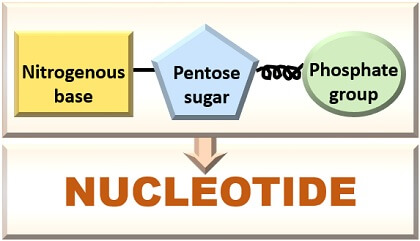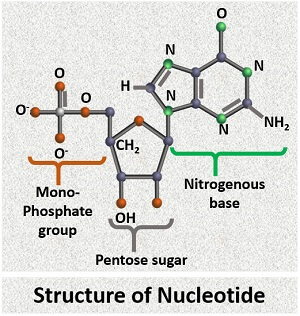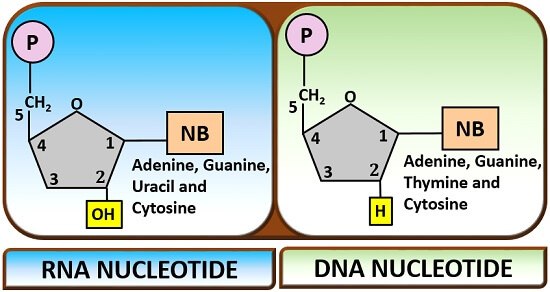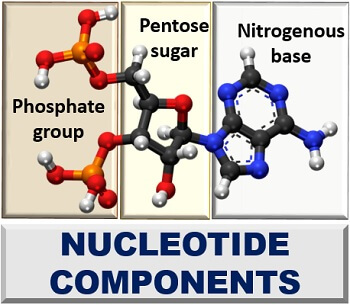A nucleotide is a compound, which can form a polynucleotide chain by the union of nitrogenous bases and sugar-phosphate group. Monomers of nucleotide units are connected via a covalent phosphodiester bond. Nitrogenous bases, i.e. purines and pyrimidine, are attached via weak hydrogen bonds. The bases link with a deoxyribose pentose sugar via an N-glycosidic bond.
There is another term “Nucleoside” which consists of two components, mainly nitrogenous bases and pentose sugar. The whole nucleoside complex attaches with the phosphate group via a strong phosphodiester bond. Thus, the sugar-phosphate group acts as a backbone of the genetic material (DNA and RNA) and provides stability to the structural configuration of the nucleic acids.
In simple words, we can say that the combination of nucleoside and phosphate group contributes to the molecular structure (Nucleotide). Nucleotides play a central role in cellular processes like metabolic regulation, signal transduction, hormonal regulation and many more functions. In this context, we will learn definition, characteristics, components, nomenclature system and functions of nucleotide.
Content: Nucleotide
Definition of Nucleotide
Nucleotides are the monomer units, forming a long polymeric chain of nucleic acid (DNA and RNA) through 3’-5’ phosphate bridges. They typically constitute the formation of DNA and RNA and possess the nitrogenous bases, a pentose sugar and a phosphate group. In DNA, the nucleotides consist of four nitrogenous bases like adenine, guanine, thymine and cytosine and deoxyribose pentose sugar with a phosphate group. In RNA, the nucleotides consist of four nitrogenous bases like adenine, guanine, uracil and cytosine and ribose pentose sugar with a phosphate group.

Properties of Nucleotide
Let us study some of the facts related to nucleotides.
The structural configuration
A nucleotide consists of a nitrogenous base, a pentose sugar and a phosphate group.
- Nitrogenous bases are the complex heterocyclic ring structure which includes adenine, guanine, cytosine and thymine bases in DNA and uracil is present instead of thymine in RNA.
- In DNA, deoxyribose pentose sugar is present whereas, in RNA ribose, sugar is present. In addition to DNA, nucleotides are also present in the nucleoplasm and the cytoplasm in the form of deoxyribonucleotide triphosphate. At the time of DNA replication, the enzyme DNA polymerase acts upon the deoxyribonucleotide triphosphate.
- A phosphate group attaches with the pentose sugar through a phosphodiester bond whose number can vary. In the diagram, we can see one phosphate group connects to the c5′ of the pentose sugar will refer to as Mono-phosphate.

Polymerization
The nucleotides undergo polymerization where several nucleotides combine to form a long chain called “Polynucleotide”. In some cases, the nucleotides are represented by a prefix Poly, which indicates the presence of repeating units in the polynucleotide chain of DNA or RNA. The repeating bases like Poly-A, Poly-G etc. refer as “Homopolynucleotides”.
Polynucleotide
A nucleotide makes up the biomolecules “Nucleic acid” during its polymeric state, where they show a directional polarity. In a polynucleotide chain, The 3’-OH end of one nucleoside attaches to the next 5’-phosphate group. Let us discuss the structural difference between the DNA and RNA nucleotide.

- In DNA, there are four nitrogenous bases like A, G, T and C that complementary pair with each other through the hydrogen bond. Deoxyribose is a pentose sugar present in DNA which lacks one oxygen atom at the C2-atom and attaches with the phosphate group through a phosphodiester bond.
- There are four nitrogenous bases (like A, G, U and C) and ribose (as a pentose sugar) in RNA. In ribose sugar, -OH group attaches at the C2-atom and binds with the phosphate group through a phosphodiester bond.
Components of Nucleotide
The nucleotide includes three main components like nitrogenous base, a pentose sugar and a phosphate moiety.

Nitrogenous Base
The nucleotides consist of purines and pyrimidine nitrogenous bases, commonly called “Aromatic heterocyclic compounds”. The nitrogenous base includes carbon and nitrogen atom in their structural moiety. Purines and pyrimidines are the two types of nitrogenous bases.
- Purine nitrogenous bases: The main distinctive feature is their single-ringed structure. Purines possess a benzene ring with six carbon atom. The numbering of an atom is in an “Anticlockwise direction”.
- Pyrimidine nitrogenous bases: They have a double-ringed structure. It contains a five-carbon imidazole ring attached with the six-carbon benzene ring. The numbering of an atom is in a “Clockwise direction”.
Pentose Sugar
The sugar present in a nucleotide chain is a pentose sugar. The pentose sugar in the structural moiety of the polynucleotide chain can be either deoxyribose or ribose sugar. Both deoxyribose and ribose sugars are the five-carbon monosaccharides or pentoses, which occur in the DNA and RNA, respectively. The structural difference between deoxyribose and ribose sugar is due to the deficiency of one oxygen at the second carbon atom of deoxyribose.
Phosphate Moiety
The phosphate group attaches to the pentose sugar in the polynucleotide chain of the nucleic acids. Both phosphate and sugar join with each other via “Phospho di-ester bond” which holds the backbone tight in the nucleic acid. The phosphate group or PO4-3 is attached to the pentose sugar one at 3’-end and another at 5’-end in the polynucleotide chain.
Nomenclature
The pentose sugar, i.e. deoxyribose or ribose sugar combines with the nitrogenous bases and contribute to the formation of molecular compound (Nucleoside). When a phosphate group joins to the nucleoside complex, it will contribute to the formation of a molecular compound (Nucleotide).
- A pentose sugar, i.e. deoxyribose combines with all the four bases like adenine, guanine, thymine and cytosine to form “Deoxyribonucleosides”.
- A pentose sugar, i.e. ribose combines with all the four bases like adenine, guanine, uracil and cytosine to form “Ribonucleosides”.
- If a phosphate group combines with the deoxyribonucleosides, it will form a “Deoxyribonucleotide chain.
- If a phosphate group combines with the ribonucleosides, then it will form a “Ribonucleotide” chain.
The nomenclature of nucleotide is based on the number of phosphate groups added to both deoxyribonucleosides and ribonucleotides. The nomenclature of ribonucleotide is given in the table below, representing the incorporation of a single phosphate group to the ribonucleoside.
| Nitrogenous base | Ribonucleoside | Ribonucleotide (Addition of single phosphate group) | Abbreviation | Nucleic acid |
|---|---|---|---|---|
| Adenine | Adenosine | Adenosine mono phosphate | AMP | Ribonucleic acid |
| Guanine | Guanosine | Guanosine mono phosphate | GMP | Ribonucleic acid |
| Uracil | Uridine | Uridine mono phosphate | UMP | Ribonucleic acid |
| Cytosine | Cytidine | Cytidine mono phosphate | CMP | Ribonucleic acid |
Nomenclature of deoxyribonucleotide is given in the table below, which indicates the incorporation of a single phosphate group to the deoxyribonucleoside.
| Nitrogenous base | Deoxyribonucleoside | Deoxyribonucleotide (Addition of single phosphate group) | Abbreviation | Nucleic acid |
|---|---|---|---|---|
| Adenine | Deoxyadenosine | Deoxyadenosine mono phosphate | dAMP | Deoxyribonucleic acid |
| Guanine | Deoxyguanosine | Deoxyguanosine mono phosphate | dGMP | Deoxyribonucleic acid |
| Thymine | Deoxythymidine | Deoxythymidine mono phosphate | dTMP | Deoxyribonucleic acid |
| Cytosine | Deoxycytidine | Deoxycytidine mono phosphate | dCMP | Deoxyribonucleic acid |
So, we have discussed the nucleotides’ nomenclature system by understanding the addition of a single phosphate group to a nucleoside complex. But, the number of the phosphate group in the deoxyribonucleotides and ribonucleotides may differ.
- Incorporation of the two phosphate group to the ribonucleoside and deoxyribonucleoside will result in the formation of ribonucleoside diphosphate and deoxyribonucleoside diphosphate, respectively.
- Incorporation of the three phosphate group to the ribonucleoside and deoxyribonucleoside will form ribonucleoside triphosphate and deoxyribonucleoside triphosphate, respectively.
Functions
The nucleotides play a crucial role in many biological processes like:
Nucleic Acid Synthesis
The nucleotides act as “Activated precursors” where they unite to form a polymeric state “Nucleic acid”, i.e. DNA and RNA. The metabolism of nucleic acid is the anabolic process, in which a nitrogenous base, pentose sugar and a phosphate group undergo a chemical reaction to form either deoxyribonucleic acid or ribonucleic acid.
Helps in Energy Transfer
Adenosine triphosphate or ATP is the “Energy currency” used in many cellular and biological processes. ATP helps in the synthesis of ribonucleic acid. Guanosine triphosphate or GTP is a nucleotide which involves in a movement of specific molecules or ions and the conformational change in a biomolecule like protein.
Working as Coenzyme
Adenine nucleotides are the components which form certain coenzymes like FAD, NAP and NADP etc. acting as an energy molecule to carry out both the biological and biochemical pathways. Flavin adenine dinucleotide (FAD) is a coenzyme, which facilitates the oxidation of fuel molecule. Nicotinamide adenine dinucleotide is the coenzyme found in almost all living organisms, which primarily participates in the anabolic metabolism. Nicotinamide adenine dinucleotide phosphate (NADP) is a coenzyme taking part in the anaerobic reaction like the synthesis of nucleic acid and fatty acids.
Involvement in Metabolism
Nucleotide derivatives like cAMP and cGMP are the cyclic derivatives derived from adenosine triphosphate and guanosine triphosphate. Both cAMP and cGMP are the secondary messengers acting as the activated intermediates entering and regulating the metabolic pathways. cAMP regulates the allosteric mechanism in metabolic systems. The cGMP governs the action of hormones like peptide hormones.
Involvement in Signalling Processes
Cyclic nucleotides like cAMP, cGMP etc. take part in the process of “Signal transduction” where the cells communicate with their neighbouring cell. In signal transduction, a cell produces a signal in response via modifying cellular activity and gene expression.
Conclusion
Nucleotides are compositely formed by the nitrogenous bases, 5-C sugar and phosphate group, which eventually contributes to a polynucleotide chain, thereby forming nucleic acids like DNA and RNA.